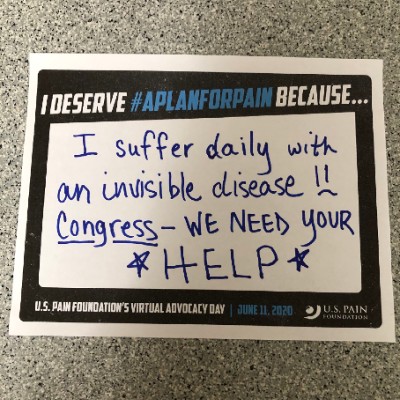
A sign created by pain warrior Sherrie Johnson.
Last month, the U.S. Pain Foundation rallied a total of 761 pain warriors nationwide to urge Congress to allocate funding for the Pain Management Best Practices Interagency Task Force report, a federal blueprint for improving pain care. Cindy Steinberg, National Director of Advocacy and Policy, served on the task force that developed the report.
Through U.S. Pain’s action campaign, 738 individuals sent 2,452 emails to Congress, and 71 individuals made 167 calls. Meanwhile, the hashtag #aplanforpain was tweeted out roughly 1,000 times across social media platforms. People from across 49 states and D.C. participated (if you live in South Dakota, or know someone who does, please join the campaign!).
“With all that’s going on in the world today, we are incredibly grateful to everyone who took the time and energy to participate in this effort,” says Nicole Hemmenway, U.S. Pain’s CEO. “The chronic pain community has long felt underserved and unheard, so we know it’s hard to feel hopeful about improvements in care. But we truly believe this report holds a lot of promise for real change in pain management nationwide.”
Hemmenway also expressed her gratitude to those organizations that helped share the action campaign, including the American Academy of Pain Medicine, American Society for Pain Management Nursing, Association of American Surgeons and Physicians, Alliance to Advance Comprehensive Integrative Pain Management, For Grace, Society for Women’s Health Research, Marfan Foundation, American Porphyria Foundation, National Headache Foundation, Miles for Migraine, Lupus and Allied Diseases Association, International Foundation for Autoimmune and Autoinflammatory Arthritis, Alliance for Balanced Pain Management, CHAMP (the Coalition For Headache And Migraine Patients), Headache and Migraine Policy Forum, and others.
In preparation for the day of action, Steinberg led a four-part Virtual Advocacy Training series for a group of top advocates as well as an informational webinar featuring Vanila Singh, MD, MACM, chair of the task force behind the report. More than 250 people joined the public webinar, which is still available to view online.
[su_pullquote align=”right”]
- 738 individuals sent 2,452 emails to Congress
- 71 individuals made 167 calls
- The hashtag #aplanforpain was tweeted out roughly 1,000 times[/su_pullquote]
Feedback from legislators
Pain warriors reported a significant amount of positive feedback. In some cases, rather than a traditional pre-written email response, pain warriors received letters from their senators or representatives that included well-informed discussion of the plight of Americans living with chronic pain and Pain Management Best Practices report–reflecting a growing awareness about pain and the report among policymakers.
Individuals who made phone calls also gained promising responses; a handful of pain warriors are currently working to schedule remote meetings with their representatives to talk more about the report and how it would affect them personally.
“I would like to thank everyone who participated in our Virtual Advocacy Day,” says Steinberg. “Although we could not be present on Capitol Hill, I think all of our pain warriors proved that we can still advocate and raise awareness about chronic pain virtually. I encourage everyone to continue the conversation with your representatives in Congress until we accomplish our goal of implementing many of the Pain Management Task Force recommendations.”
Missed out? No problem! There’s still time to make a difference
Up until Congress finalizes their budget for next year, there’s still time to take action and reach out to legislators. If you already took action, you can always share the Action Center site with your loved ones, friends, or even your pain doctor. Chronic pain affects more than patients–it impacts families, the health care system, and society as a whole. Everyone can and should participate in improving pain care.
